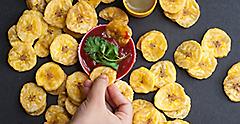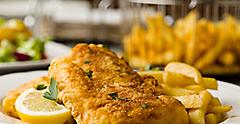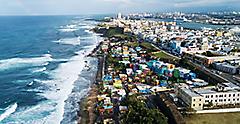It's no secret the Caribbean is home to picturesque beaches, turquoise waters and a number of vibrant cultures. An important part of those cultures is authentic Caribbean cuisine. Some of these well-known dishes are everyday staple foods to the locals, while others are only eaten on special occasions. Although some of these dishes have been on dinner tables for hundreds of years and others are newer, each is crafted with a unique blend of spices that encapsulate the essence of the islands.
Whether you find yourself in Puerto Rico enjoying arroz con gandules and pernil, or perhaps further south on the island of Curacao eating keshi yena while sipping blue curacao, your taste buds will dance after they experience the flavors of authentic Caribbean cuisine.
Caribbean cuisine is something you simply can't miss when visiting the region. Made up of more than 7,000 islands and 26 countries, each island is unique, with its landscape, people and culture each influencing the islands' cuisine. You're in for authentic Caribbean treats when visiting Puerto Rico, Curacao, Aruba and truly any of the islands scattered across the region.
Keshi Yena And Blue Curacao On The Island Of Curacao

Visiting the colorful island of Curacao is a feast for all of the senses, not just the taste buds, but perhaps the best way to get a feeling for the culture is by diving headfirst into their authentic Caribbean cuisine. There are so many influences on the island, including Dutch, Afro-Caribbean and Venezuelan, creating a wide array of flavors in each dish.
One you simply can't miss is the national dish, keshi yena. Keshi yena perfectly represents the cultural melting pot that is Curacao. With the Dutch came the islands' appreciation of cheeses — cheese wheels, to be exact. The wealthy would enjoy their premium cheese wheels and give the scraps to their workers. From the table scraps, the workers would peel off any plastic that remained on the cheese, soak the rinds in water to soften them, create a filling with other scraps like meats and vegetables and steam all the ingredients together, which created the dish of keshi yena. Today, it's served up casserole style and it is typical to see thinly sliced pieces of cheese in the shape of a bowl with a cheese topping, creating the "stuffed cheese" effect from which the dish gets its name. Wash it down with the citrusy Curaçao liqueur, otherwise known as blue curaçao.
Sancocho In The Dominican Republic
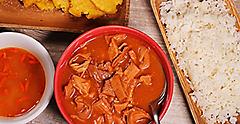
Like ropa vieja, sancocho hails originally from the Canary Islands and is authentic Caribbean cuisine. It made its way through Colombia and Ecuador before eventually landing in the Dominican Republic. You'll find several different versions of the seven-meat stew in the Dominican Republic, depending on the cook and the region.
The meats vary, but some of the most common you'll find are goat meat, beef, pork and chicken. Bones of the chicken are often included to add flavor. Along with the salty broth and different meats, several root vegetables are also included. Sancocho is typically served for dinner with a side of rice and avocado.
Oil Down In Grenada
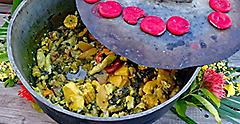
A staple at the dinner table and special gatherings such as the annual Carnival bacchanal, oil down always brings people together. Nearly every meat and vegetable that's included in the stew demonstrates the origins of Grenada’s culture.
The technique of "packing the pot" is used to create this delicious dish. Typically, the breadfruit and meat go in the bottom of the pot, vegetables in the middle and the callaloo leaves and dumplings on top, then the dish is perfectly spiced with turmeric. Oil down gets the name from the mixture of coconut oil and meat juices that settle at the bottom of the pot. The dish is a must-try when it comes to authentic Caribbean cuisine.
Ackee And Saltfish In Jamaica
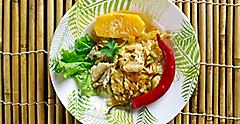
Puerto Rican Arroz Con Gandules And Pernil

Puerto Rican arroz con gandules and pernil is mainly served on special occasions and holidays. Like many other dishes, it dates back to the 18th century. Its roots are found in Spain and Africa, while many of its ingredients are influenced by the United States.
The recipe name translates as "rice with pigeon peas and pork." It's a beloved national dish and a must-try when visiting the island of Puerto Rico. Wash it down with a pina colada, which is one of the signature Caribbean island drinks.
Cracked Conch In Turks And Caicos
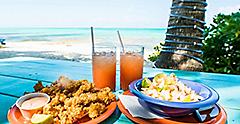
Haitian Griots With Rice And Beans
Griots with rice and beans is arguably the most popular dish of Haiti and a great example of authentic Caribbean cuisine. Cubes of marinated pork are boiled and then fried, and then typically served with rice and beans, peas and/or fried plantain.
Haiti's cuisine differs from the rest of the Caribbean islands because of its roots in Creole-style cooking. Creole-style cooking blends West African, French, Spanish, Native American, Haitian, and British flavors with influences from the cuisine of the southern states, creating unique dishes unlike anywhere else in the Caribbean. Strong pepper flavoring, beans and starches like yam and rice are staples you can find in almost any Haitian dish. The cuisine is largely locally grown and historically crafted around a working-class income.
Belizean Rice And Beans With Fish Stew
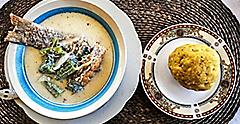
Belizean cuisine has adopted some of the same cooking techniques and flavor profiles as the Mexican, Caribbean and Mayan cultures. As in Mexico, the combination of rice and beans is a popular pairing here, making for an interesting twist on a seemingly familiar dish as well as authentic Caribbean cuisine.
Often, the rice in Belize is cooked in coconut milk and various spices, making it different from Mexican-style rice. Fish stew is served on the side or atop the coconut rice. Sip on a Belikin (Belizean beer) and finish off the meal with soursop, ice cream made from soursop fruit mixed with condensed milk.
Fungi And Fish In The British Virgin Islands
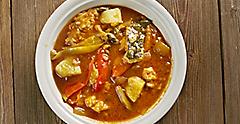
Cou-Cou And Flying Fish Of Barbados
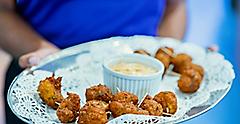
Barbadian cuisine is known for its freshness, flavor and variety, much like the authentic Caribbean cuisine from nearby islands. There are many local delicacies to try when visiting Barbados, but cou-cou and flying fish has to be on your list! It's also the origin of one of Barbados's nicknames, "the land of the flying fish."
In this dish, the flying fish is steamed, fried or pickled and served with cou-cou, which is a creamy porridge of cornmeal, flour and okra. The whole thing is often served with vegetables and/or rice. Finish your meal with a slice of the sweet Bajan treat called coconut bread.
Callaloo Soup Of St. Martin
St. Martin is most known for its French-style cuisine with a Caribbean twist. Grand Case, a village located on the northwest side of the island and known as the "gastronomic capital of the Caribbean," is one of the best spots on the island to try authentic Caribbean cuisine.
In addition to oxtail stew, johnny cakes and the jacks (or fried fish), you simply have to try the callaloo soup. This is a thick green soup made from leafy greens and sometimes pork cubes. Other ingredients in the soup include hot peppers, okra, black pepper, thyme and chicken stock. After you've gotten your savory fix, try a delicious sweet French pastry as dessert.
Green Fig And Saltfish In St. Lucia

Believe it or not, green fig and saltfish actually doesn't contain any figs — instead, the "green figs" are unripe green bananas that are boiled and stewed to create a delicious example of authentic Caribbean cuisine.
The saltfish, which is typically cod, is salted and then boiled and rinsed to remove the salt. The fish is then added to a braising pan with seasoning, and once the bananas are boiled, they're added to the braising pan with the saltfish to create a mixture of island flavors that everyone will love! In St. Lucia, green fig and saltfish is served as a weekend breakfast and on the Creole Day Festival in October.
Get Royal Deals, Sign Up Today

Getting There
Explore Our Most Affordable Itineraries
Enjoy delicious Caribbean cuisine when visiting the region on your cruise.


